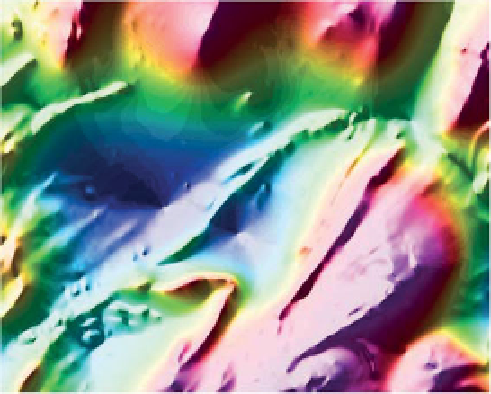Geoscience Reference
In-Depth Information
g)
h)
0
5
Kilometres
5
8
6
8
i)
Figure 3.28
(cont.)
simplify the response are mostly applicable to magnetic
data. The aim is to transform the dipolar response charac-
teristic of mid-latitudes to the simpler monopole response
emphasise responses from shallow depths by enhancing
their short-wavelength responses. Both wavelength and
gradient
the body
is magnetism is vertical, the resultant anomaly can
be difficult to relate to the geometry of its source. Fortu-
nately for the interpreter, the problem is addressed by two
processing operations: the reduction-to-pole (RTP) and
the pseudogravity (PSG) transforms. Both are forms of
anomaly simplifier making magnetic data much easier to
analyse and allowing comparisons of data from different
magnetic latitudes.
'
filters are commonly used and allow structure to
be mapped in considerably more detail than in the
'
data. The long-wavelength responses of large and deep-
seated features can also be enhanced using wavelength
filters.
'
raw
3.7.2.1
Reduction-to-pole
The reduction-to-pole operator transforms magnetic
anomalies resulting from the inclined magnetism of non-
polar regions into their equivalent polar response where a
body
3.7.2
Reduction-to-pole and pseudogravity
transforms
is magnetism is vertical; compare
Figs. 3.26a
and
d
.
Polar magnetic anomalies resemble gravity anomalies in
that they are monopolar and occur directly above their
source, but with the advantage of being more localised to
the source than gravity anomalies. The resolution of close-
spaced sources is improved. Derivative enhancements are
'
As shown in
Figs. 3.25a
and
3.26a
, magnetic responses are
much more complex than gravity responses, owing to the
dipolar nature of magnetism and the possibility that the
magnetisation of the body can be in any direction. Unless




















Search WWH ::

Custom Search